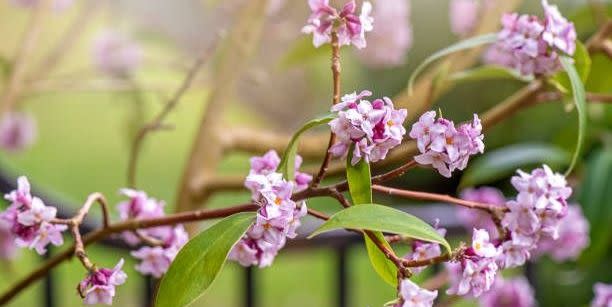How Do You Grow and Take Care of Daphne Plants?

With varieties like perfume princess and eternal fragrance, it doesn’t take long to figure out the daphne shrub is known for its sweet, fruity fragrance in addition to its pretty clusters of white, pink, or lavender blooms. Plus, their flowers arrive in late winter or early spring, brightening those final dull cold days. "These shrubs are great because they bloom early when not much else is going on in the garden," says Mike Duvall, woody program manager for Star Roses & Plants. “Once established, they're easy to care for, and they have a nice compact form.”
Evergreen shrubs and spring and summer-flowering shrubs are delightful, to be sure, but none quite matches the scent and early bloom timing of the daphne shrub. But do you take care of it to ensure it delights you in its full form? Here’s what you need to know about the best place to plant the shrubs, how to grow them in pots, where to buy them, and whether they need sun or shade.
What types of daphne shrubs should I plant?
If you live somewhere that has severe winters, we have bad news. Daphne shrubs grow in USDA Hardiness zones 6 to 9. Be sure to look at a particular plant's tag when you buy it since different species have different light requirements from full shade to full sun. In hot climates, daphne shrubs fare better with afternoon shade. Some species are evergreen and grow flowers in clusters or along stem tips, while other types keep blooming throughout the summer. Best of all, you don't have to worry about them after they are grown. They max out at three to four feet tall and wide and have a rounded shape.
Varieties to try:
Eternal Fragrance
Marianni
Carol Mackie
Where do I buy daphne shrubs?
Daphne shrubs have become more popular in the last few years, but they’re still not easy to find. They’re also slow-growing, which makes them pricier than other types of shrubs of the same size. Independent garden centers and small nurseries, rather than big box retailers, are more likely to carry daphne shrubs. Look for them in late winter to mid-spring, just as they get ready to bloom. You also can buy from online retailers, which tend to have more varieties available.
Pick the right spot for your daphne shrub.
The most important issue is to find a spot where your plant will be happy; make sure you read the tag so you know how much sun it can tolerate. But remember that these shrubs do need some sun to bloom, so don't bury them in the shade. Most of all, daphne shrubs don’t like dry compacted soil or overly wet soil so look for a well-drained spot, says Duvall.
Dig a hole about twice the diameter and about the same depth as the pot. Don’t put the plant in too deep, which is a common mistake; daphne shrubs actually prefer their root ball to be set about a ½ inch higher than the ground around them. Refill soil around the plant, water well, and mulch. Water a few times a week for the first few weeks and during dry spells as they get established, especially the first year or two.
You also can plant daphne shrubs in containers and place on either side of your entry to enjoy their amazing fragrance. But make sure there’s a hole in the pot for drainage, and don’t let water sit in the saucer beneath the pot. Important note: All parts of the plant are toxic if ingested, so be careful about placement—and little kids and pets away.

Do I need to prune daphne shrubs?
Daphne plants are low-maintenance once established, says Duvall. At the start of their second season in the ground, give them a little 10-10-10 slow-release granular fertilizer. If there’s a broken or damaged limb, trim it off. But you don’t need to prune to maintain their shape. In fact, these shrubs bloom on last year’s growth, so if you do need to shape them or take off a wonky branch, cut immediately after flowering is done to preserve next year's blooms.
You Might Also Like

 Yahoo News
Yahoo News 
